Roger SESSIONS
(1896-1985)
Symphony No.1 (1927); Symphony No.2 (1946);
Symphony No.3 (1957)
 Japan PO/Akeo Watanabe
18.00; New York Philharmonic-Symphony/Dimitri Mitropoulos - mono 25.18; Royal
PO/Igor Buketoff 30.08
Japan PO/Akeo Watanabe
18.00; New York Philharmonic-Symphony/Dimitri Mitropoulos - mono 25.18; Royal
PO/Igor Buketoff 30.08
 COMPOSERS RECORDINGS
INC CRI CD 573
[73.26]
COMPOSERS RECORDINGS
INC CRI CD 573
[73.26]
Amazon
UK
Amazon
USA
www.composersrecordings.com

The first symphony sandwiches a serene Pavane in which Bach might be said
to have met Samuel Barber between two movements of shoaling Stravinskian
activity, sometimes aggessive; sometimes jazzy. This is the most approachable
route into the Sessions symphonies.
Sessions' second symphony forms a watershed. In it the composer achieved
a full transition to his mature style. The death of President Roosevelt occurred
while Sessions was working on the piece and his grief at the nation's loss
is reflected in the sombre wayward passion of the adagio (think Frank Bridge's
There is a Willow) and explains some of the bereft anger in the outer movements.
Rather like the Wolpe symphony, contemporary critical reaction referred to
the need for a longer term process of understanding its complex logic. On
12 January 1950 the NYPO, conducted by Mitropoulos, gave a concert performance
which directly resulted in a Naumburg Foundation grant for the present recording.
This wears its years least well among the three symphonies - being abrasive
(when the strings are high and under pressure), somewhat afflicted with hiss
and in mono. In the dour allegramente of No. 2 and the awkward 'bull in a
china shop' allegro con fuoco of No. 3 Sessions returns very close to the
Stravinskian dynamism of the first symphony's outer movements but with a
highish quota of dissonance.
The third symphony was a Koussevitsky Foundation commission and, quite naturally,
it was the Boston Symphony who premiered it with Munch (who must have found
it a less than congenial experience given his usual predilections).The Symphony
is also in four movements. It launches encouragingly in quiet Stravinskian
mood alive with latent energy (Rite of Spring) but is soon soaring and diving
free of the compass of tonality. As ever with Sessions there is a great deal
going on and this impatient activity seeps into the bones of the second movement.
The andante can be compared with the elegiac FDR adagio of No.2.
A special word of praise for CRI's design standards. They are distinctive
and timeless. The notes are useful though I deprecate the absence of any
information about the recording dates which must span the period from circa
1950 to 1970.
Content
Rob Barnett

